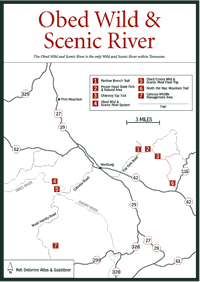
[Fig.
10(7)] The 82,000-acre Catoosa Wildlife Management Area (WMA) is another
of the large tracts on the plateau that has made a comeback from the devastation
created by earlier coal and lumber operations. Today it is one of the state's
premier nature and wildlife areas.
Catoosa's history is similar to that of many parts of the plateau where such activities were rampant. Initially the area was one of the prized hunting grounds visited seasonally by the Cherokees, Choctaws, Chickasaws, and Shawnees, who often engaged in bitter battles over their individual hunting rights. Later, the longhunters of the Daniel Boone era also came to seek game, and eventually small settlements sprang up.
In the 1870s the first lumber operation got underway, and by 1911, two coal and lumber companies had formed a syndicate that continued to exploit the region until a massive flood in 1929 wiped out the main bridges on their rail lines. In the meantime, the companies were leasing lands where all of the timber had been removed for crops and livestock grazing. The result was an increase in the number of small farms in the area.
The flood and the ensuing Great Depression virtually eliminated the coal and lumber operations, and in 1940 the Crossville Exchange Club appointed a committee to encourage the state to purchase a large tract of the abandoned land for a wildlife management area. In 1942 the Conservation Commission made the initial purchase of 63,000 acres from the Tennessee Mineral and Lumber Company with Pittman-Robertson federal aid funds, which come from federal taxes on guns and ammunition.
In 1949 the Tennessee Game and Fish Commission, now the Tennessee Wildlife Resources Agency (TWRA), established a tentative purchase boundary which encompassed approximately 90,000 acres. A land acquisition program designed to eliminate interior holdings was begun at that time and continues today.
The Catoosa WMA lies within the Emory River drainage, which is divided by a number of major stream drainages, including the Obed River, Daddy's Creek, Clear Creek, and Otter Creek. The terrain is moderately rolling, ranging in elevation from 1,100 feet to 2,300 feet, with deep canyons cut by the streams.
More than 98 percent of the Catoosa WMA is now forested, which is in sharp contrast to what some early travelers observed. In 1797, Francis Bailey wrote, "...about five o'clock we arrived at Crab Orchard. Here we found a large plain or natural meadow, containing many hundred acres covered throughout its whole extent with a tall, rich grass." Two years later, in 1799, Martin Steiner wrote, "...then we crossed barren hills where only bushes grew. Now and then one saw a little tree." There were many other such accounts indicating the open nature of the terrain and the presence of great herds of elk, deer, and bison.
Ecologists believe extensive grazing and periodic burning by the Indians were the reasons for the prairielike conditions. The plant succession that followed when the game and Indians were gone reforested the area, and then, around 100 years later, the lumbering operations again laid the land virtually barren of timber. Now, almost 70 years since that activity halted, the plateau's woodlands are again flourishing.
As a part of the management program, the wildlife populations have been restored, and the Catoosa WMA is one of the most popular places in the region for hunters seeking big or small game. The deer herd is in excellent condition and regularly produces trophy bucks, and wild turkey numbers continue to climb. Also present are the exotic European wild boar, which can be hunted during all of the deer seasons. Small game includes fox squirrels, gray squirrels, ruffed grouse, raccoons, quail, rabbits, and mourning doves (Zenaidura macroura).
The streams in the Emory River drainage offer anglers the opportunity to seek a number of game fish. Smallmouth bass, rock bass, bluegill, and muskellunge are the most prevalent species. Many of these waters are in remote and rugged country, and access to them is limited. Parts of some of the streams are floatable, and many of these stretches are included in the Obed Wild and Scenic River System.
Due to the increasing pressure being applied by outdoor users of all kinds, the Tennessee Wildlife Resources Agency (TWRA) has closed Catoosa and several other WMAs to entry between sunset and sunrise. This is intended to reduce the effect of the activities that are considered incompatible to established wildlife management practices.
Since WMAs were purchased by funds generated by hunters, the TWRA regards hunting as the first and foremost priority on these areas. Currently, off-road vehicles and horses are permitted, but only on certain roads and trails. Overnight camping is allowed on designated areas by permission of the area manager. Such camping is subject to the limitation on the permit.